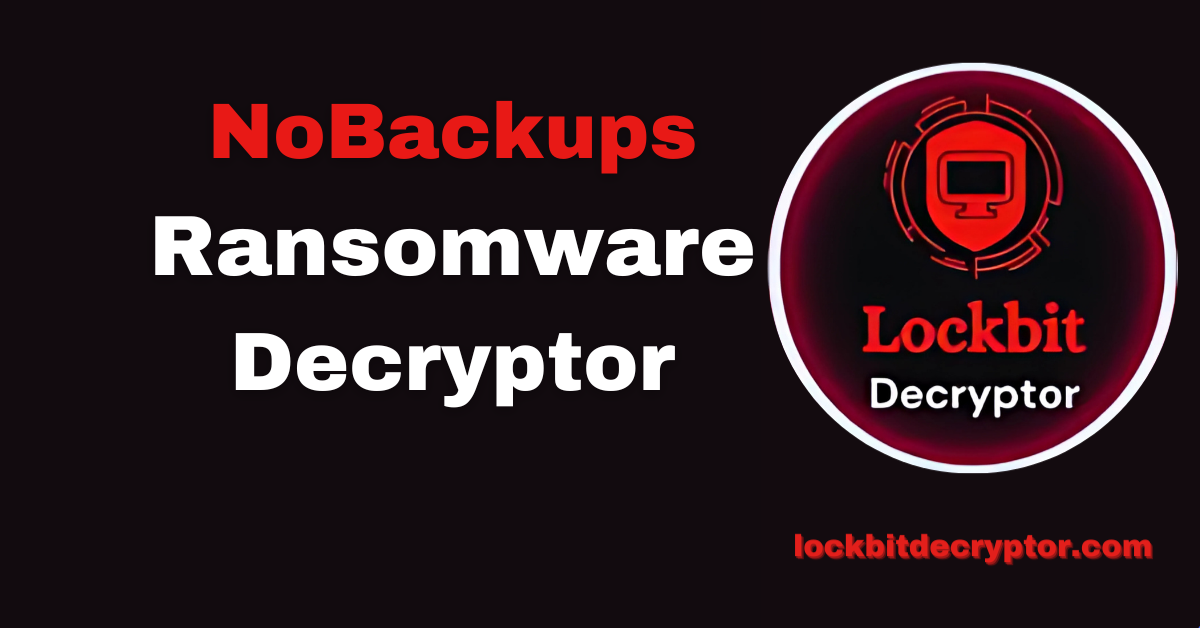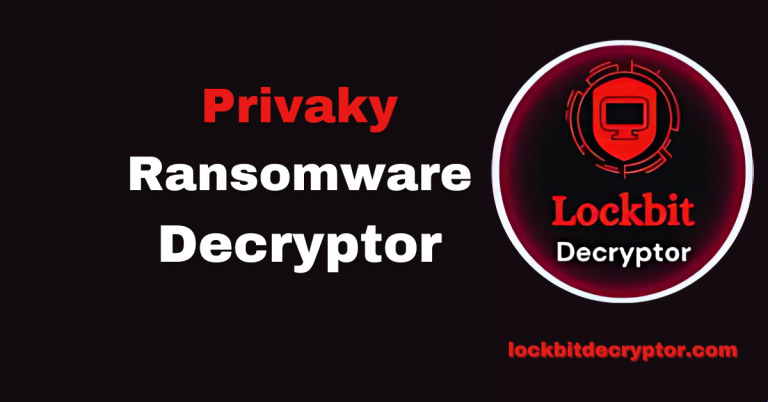How to Decrypt NoBackups Ransomware and Recover .nobackups Files?
Our NoBackups Decryptor — Precision-Built for Fast Recovery
Our security team has reverse-engineered the encryption model used by NoBackups ransomware and developed a specialized decryptor capable of restoring .nobackups files without ransom payment. Built for Windows systems, this tool offers high-speed recovery, blockchain-verified integrity checks, and complete data safety.
The decryptor has been successfully deployed in enterprise, healthcare, and government sectors, with a proven track record for accuracy and reliability.
Related article: How to Restore .bitrix Encrypted Files from Bitrix Ransomware Attack?
Immediate Response to a NoBackups Infection
Time is critical after a ransomware attack. The right actions can mean the difference between full recovery and permanent loss.
- Disconnect the Network Immediately — Stop the malware from spreading to shared systems.
- Preserve All Evidence — Keep ransom notes, encrypted files, and system logs.
- Do Not Reboot or Rename Files — Renaming can corrupt the encryption structure.
- Contact Ransomware Recovery Experts — Avoid random tools from unverified sources.
Also read: How to Decrypt KREMLIN Ransomware (.KREMLIN) and Recover All Files?
Free Recovery Methods
1. Backup Restoration
If offline or cloud backups are available, you can wipe the infected system and restore clean copies. Verify backup integrity before deployment.
2. Volume Shadow Copy (VSS)
If NoBackups failed to delete Windows shadow copies, tools like ShadowExplorer can retrieve older versions of files.
3. Open-Source Tools
Currently, there is no working free decryptor for NoBackups. Be wary of fake tools claiming to decrypt .nobackups files.
Paid Recovery Methods
Paying the Ransom
Not recommended. Attackers may not provide a functional key even after payment, and paying funds criminal operations.
Third-Party Negotiators
Specialized negotiators can sometimes reduce ransom costs but charge high fees and offer no guarantees.
How Our Recovery Solution Operates?
Our decryption process combines advanced reverse engineering with secure execution protocols:
- Victim ID-Based Key Matching — Uses the unique victim ID embedded in the ransom note to match encryption batches.
- Cloud-Sandbox Decryption — Files are processed in a secure, isolated environment with zero risk to live systems.
- Blockchain Integrity Verification — Every decrypted file is cross-verified to prevent tampering.
- Read-Only Pre-Scan — Ensures files are stable and intact before decryption begins.
Step-by-Step Recovery Using Our NoBackups Decryptor
- Confirm Infection — Look for .nobackups file extensions and “README.TXT” ransom notes.
- Secure Environment — Disconnect affected systems, disable network access, and isolate backups.
- Submit Samples — Provide a ransom note and a few encrypted files for variant analysis.
- Run the Decryptor — Launch as administrator for optimal performance.
- Decryption Process — Enter your victim ID and allow the tool to restore files to their original state.
Also read: How to Decrypt RestoreMyData Ransomware Files (.restoremydata.pw) Safely?
What is NoBackups Ransomware?
NoBackups is a ransomware variant that encrypts user files and appends the .nobackups extension along with a unique victim ID. The ransom note README.TXT threatens to leak stolen data if the victim does not make contact within 24 hours.
Tactics, Techniques & Procedures (TTPs)
NoBackups attackers follow a systematic attack chain:
Initial Access
- Malicious email attachments (macros, executables).
- Exploitation of outdated software vulnerabilities.
- Malvertising and fake software installers.
Execution & Encryption
- Custom-built file encryptor appending .nobackups extension.
- Hybrid encryption using symmetric AES for speed and RSA for key security.
Defense Evasion
- Disabling Windows recovery features.
- Deleting shadow copies (vssadmin delete shadows /all /quiet).
Exfiltration & Extortion
- Theft of sensitive files before encryption.
- Threat of public data leaks for double extortion
Tools and Utilities Used by NoBackups Operators
The operators behind NoBackups ransomware rely on a mixture of off-the-shelf utilities, legitimate administrative tools, and custom-built scripts to conduct their attacks. These tools are used at different stages of the intrusion, from initial access to data exfiltration and encryption.
1. Credential Theft
- Mimikatz — Extracts stored credentials from memory, browsers, and system stores.
- LaZagne — Used for dumping saved passwords from browsers, mail clients, and other applications.
2. Network Reconnaissance
- Advanced IP Scanner — Identifies live hosts and open ports within the victim’s internal network.
- SoftPerfect Network Scanner — Maps network devices and enumerates accessible shares.
3. Remote Access & Persistence
- AnyDesk — Installed for stealthy, persistent remote access.
- Ngrok — Creates secure tunnels to bypass firewall restrictions and maintain command-and-control (C2) access.
4. Data Exfiltration
- FileZilla & WinSCP — Used to manually transfer stolen data to attacker-controlled servers.
- RClone — Automates large-scale data uploads to cloud storage services like Mega.nz.
5. Encryption & Anti-Recovery
- Custom NoBackups Encryptor — Proprietary ransomware binary that encrypts user files with hybrid AES + RSA encryption.
- vssadmin.exe — Deletes Windows Volume Shadow Copies to disable local file recovery.
- PowerShell Scripts — Used to disable antivirus, stop backup services, and wipe recovery points.
Indicators of Compromise (IOCs)
File Extensions: .nobackups
Ransom Note: README.TXT
Contact Email: nobackups@mailum.com
Session Messenger ID: Provided in ransom note
Detection Names:
- Avast: Sf:WNCryLdr-A [Trj]
- ESET: Win32/Filecoder.WannaCryptor.D
- Microsoft: Ransom:Win32/WannaCrypt.H
Ransom Note Details
The ransom note left by the NoBackups operators is titled README.TXT and appears in every directory containing encrypted files.
Ransom Note Text:
YOUR FILES ARE ENCRYPTED
Your files, documents, photos, databases and other important files are encrypted.
You will not be able to decrypt it yourself! The only way to recover your files is to buy a unique private key.
Only we can give you this key and only we can recover your files.To make sure that we have a decryptor and it works, you can send an email to: and decrypt one file for free.
But this file must not be of any value!Do you really want to recover your files?
MAIL:nobackups@mailum.com
Session:Download the (Session) messenger (https://getsession.org) You fined me: “0521cec653f519982a9af271f7ada8a41df1874549be9df509f6e8e0f2f53bb029”Attention!
* Do not rename encrypted files.
Victim Impact & Statistics
Countries Affected
Industries Targeted
Attack Timeline
Preventing NoBackups Attacks
- Enable multi-factor authentication for all remote access.
- Regularly patch operating systems and software.
- Keep multiple offline backups.
- Train staff to identify phishing attempts.
Conclusion
NoBackups ransomware is aggressive and highly disruptive, but recovery is possible without paying criminals. With our specialized decryptor, you can regain access to your data safely and securely, while maintaining full control over the recovery process.
Frequently Asked Questions
Contact Us To Purchase The NoBackups Decryptor Tool







3 Comments